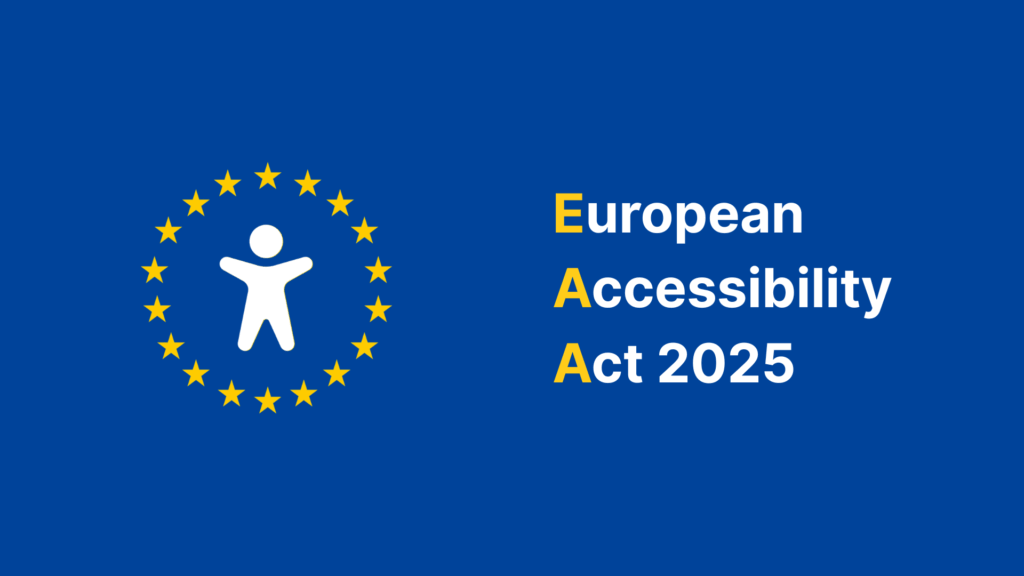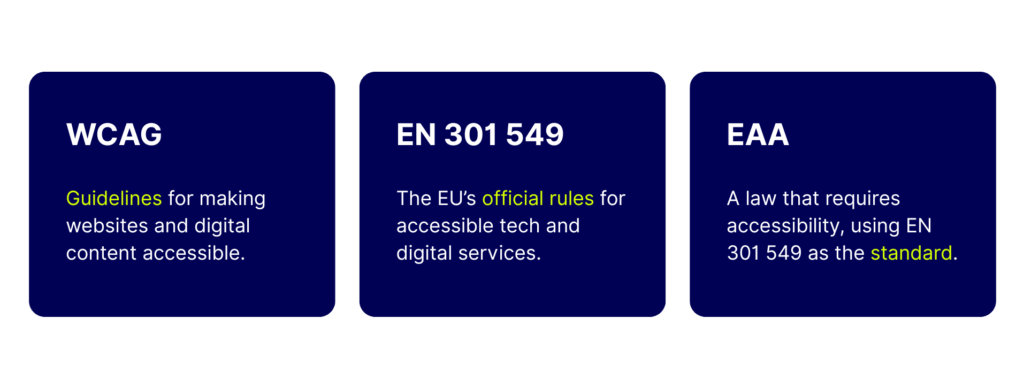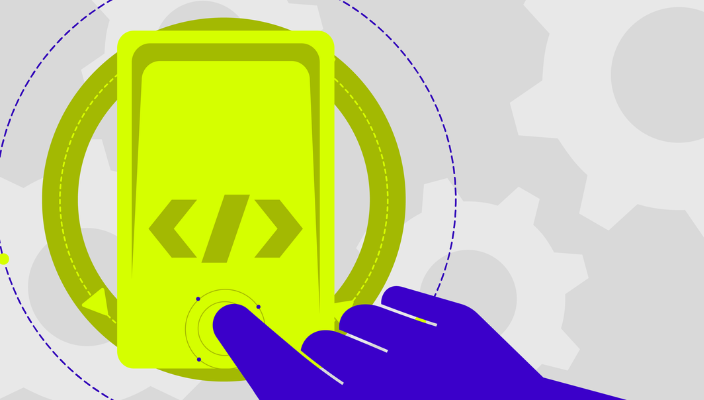This guest blog on the European Accessibility Act is written by Dr. Thomas Hein, Head of Digital Inclusion at Arc Inclusion and Head of Customer Research at REO Digital. With a background in decision-making psychology and over a decade of experience, Thomas helps organisations embed accessibility and user insight into their design systems, development workflows, and leadership practices. He’s worked across sectors including finance, retail, utilities, and healthcare, and is known for making accessibility and UX practical, evidence-based, and commercially relevant.
Arc Inclusion is a consultancy that partners with organisations to build inclusive digital products and services — combining accessibility expertise with deep design and delivery know-how.
REO Digital is a user research and service design agency that helps teams deliver digital services grounded in real user needs — ensuring they are not only usable but inclusive by design.
In this blog, Thomas shares practical guidance on navigating one of the biggest shifts in digital accessibility policy to date: the European Accessibility Act.
The countdown is on: by 28 June 2025, the European Accessibility Act (EAA) will come into full effect across the EU. For organisations offering digital products and services, it marks a decisive shift. No longer optional, accessibility will become a legal requirement for doing business in Europe. Yet for many, the specifics remain unclear — and misconceptions are rife.

1. Why the European Accessibility Act Matters — and Who Can’t Afford to Ignore It
The European Accessibility Act is an EU directive designed to harmonise accessibility requirements across member states. It covers both physical and digital goods and services — from banking apps to e-commerce platforms, transport ticketing systems to e-books — and aims to ensure that people with disabilities can use and interact with them on equal terms.
But it doesn’t stop at EU-based companies. If your business sells to EU customers, the EAA applies to you, even if you’re based in the UK or elsewhere. Whether you’re an online retailer shipping to Berlin, a banking app available in Madrid, or a ticketing platform used in Paris — the legislation counts.
Failing to comply could mean more than a slap on the wrist. Each EU country has the power to set and enforce its own penalties. That means fines can pile up — ranging from €5,000 to €500,000 depending on the market — and, in some cases, your product could be banned from sale altogether.
And if you’re trying to secure public sector contracts — or selling into other businesses as a B2B supplier or SaaS provider — forget it: non-compliance is a non-starter.
More and more organisations, not just governments, are embedding accessibility requirements into procurement processes, meaning your product won’t even make it onto the shortlist without meeting the EAA.
2. Think WCAG Is Enough? Think Again.
To understand what the EAA demands, it’s important to get clear on two key standards:
- WCAG (Web Content Accessibility Guidelines) is a globally recognised framework developed by the W3C. It outlines best practices for making web content more accessible to people with disabilities — covering things like text alternatives, keyboard navigation, and colour contrast. It’s a strong foundation for digital accessibility, but it’s not a law.
- EN 301 549 is the official European standard for accessibility of ICT (Information and Communication Technologies) products and services — including websites, apps, documents, software, and hardware. It references WCAG, but also goes beyond it to cover additional requirements such as assistive tech compatibility, non-web software, hardware interfaces, and support services. EN 301 549 is the technical benchmark the EAA uses to define compliance.
Here’s where things get tricky — and where many agencies, consultancies, and suppliers get it wrong.
Some will tell you that WCAG 2.2 AA compliance is all you need to meet the EAA’s requirements. But that’s a dangerously oversimplified take.
Let’s break it down with a metaphor:
Think of building an accessible digital product like organising a music concert.
- WCAG is your production handbook — it helps you plan things like lighting, stage layout, and how to ensure clear signage and smooth crowd flow. It’s full of best practices, but it’s not the law.
- EN 301 549 is the venue inspection checklist — it’s what the safety inspectors go through to ensure things like accessible seating, fire exits, and hearing loop systems are in place. It’s technical and detailed, and helps you prove you’re meeting the requirements.
- The European Accessibility Act (EAA) is the legal permit to run the show — no matter how good the performance is, if the venue isn’t accessible to disabled fans, the event can be cancelled, fined, or banned from future bookings.

You can plan with the best of intentions, but if wheelchair users can’t get to their seats, or if blind fans can’t navigate the ticketing system, it’s not just a bad experience — it’s a legal failure.
Accessible experiences aren’t just about following a checklist. They’re about making sure everyone gets to enjoy the show.
Importantly, following WCAG alone won’t make you compliant. Using overlays will make things worse. And automated tools alone are unlikely to even get you close.
If your vendor says otherwise, be wary. Either they don’t understand the EAA or they’re trying to sell you an easy fix that doesn’t deliver. The risk? Your organisation spends money on remediation — and still faces penalties, brand damage, and restricted access to EU markets.
3. How to Prepare for European Accessibility Act Compliance: Key Steps for 2025
The truth is, we’re basically almost there! While 2025 might have felt far off, the truth is that compliance isn’t a one-off task. It’s a journey (an Arc, a story) — and one that requires technical, organisational, and sometimes cultural change.
Here are the key steps every business should be considering now:
1. Audit Beyond WCAG
Start with a comprehensive audit — but make sure it goes beyond WCAG. Check content, functionality, and code against EN 301 549. This includes things like voice control support, modifiable captions, multi-channel ICT and hardware like public terminals, and accessible customer support channels.
2. Check Your Entire Ecosystem
Accessibility isn’t just about websites. If you provide a mobile app, self-service kiosk, e-book, or even real-time transport updates — you’re likely within the EAA’s scope.

3. Map Internal Capabilities
Do your teams have the knowledge and skills to implement accessibility best practices? If not, now’s the time to train developers, designers, and product teams. Ensure that accessibility is baked into your sprints, not bolted on later.
4. Update Procurement & Partnerships
If you rely on vendors or third parties for platforms, customer service tools, or payment infrastructure, check their compliance too. You are responsible for what your customers experience, even if a supplier built it.
Accessibility isn’t static. Conduct regular user testing — ideally with disabled users who use assistive technologies — to catch issues that automated tools miss. Screen reader compatibility, captions, contrast, and keyboard access should all be part of your checklist. And don’t stop at audits — experiment. Try small changes, test them, and see what actually improves the experience. Tools like AB Tasty make it easier to run inclusive A/B tests and make sure your updates work for everyone.
4. Compliance Is Just the Start — Accessibility Is a Business Superpower
It’s easy to see the EAA as just a legal hurdle — but accessibility is a strategic advantage, not a sunk cost. It’s a long-term investment in growth, resilience, and relevance: here’s why:
- Inclusive design broadens your market — especially in Europe, where over 135 million people live with disabilities and millions more experience temporary, age-related, or situational impairments.
- Accessibility also improves usability for everyone, enhances brand reputation, and drives innovation (think captions, voice interfaces, dark mode — all born from accessibility).
- Demonstrating a commitment to inclusion and equity builds brand trust and aligns your brand with modern values.
- Customers increasingly expect inclusive digital experiences, and organisations that lead in this space enjoy stronger loyalty, better SEO, and increased conversions.
- Accessibility reduces legal and reputational risk — but more than that, it’s simply good business.
In the race toward compliance, those who see accessibility as an enabler, not a burden, will pull ahead.
Final Thought
The European Accessibility Act isn’t just about avoiding fines — it’s about recognising that inclusive design is better design. The businesses that succeed won’t just be those that hit the compliance deadline, but those that embed accessibility into their core values, the way they work, and their working culture.
If your teams are overwhelmed or don’t know where to start, don’t fall for quick fixes or checkbox audits. The right partner will help you build lasting capabilities — and a digital experience that works for everyone.







